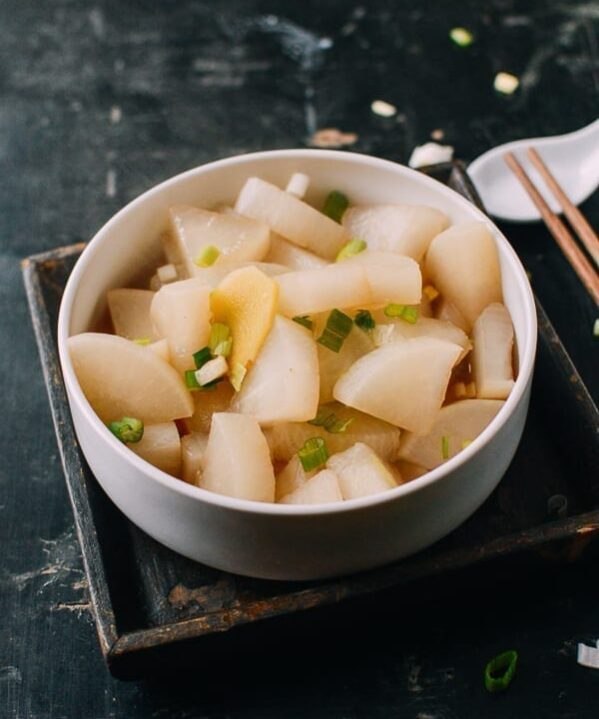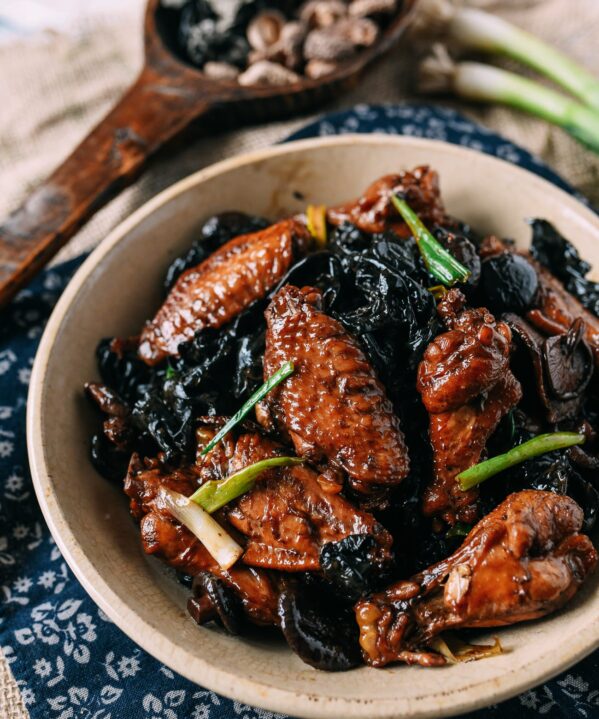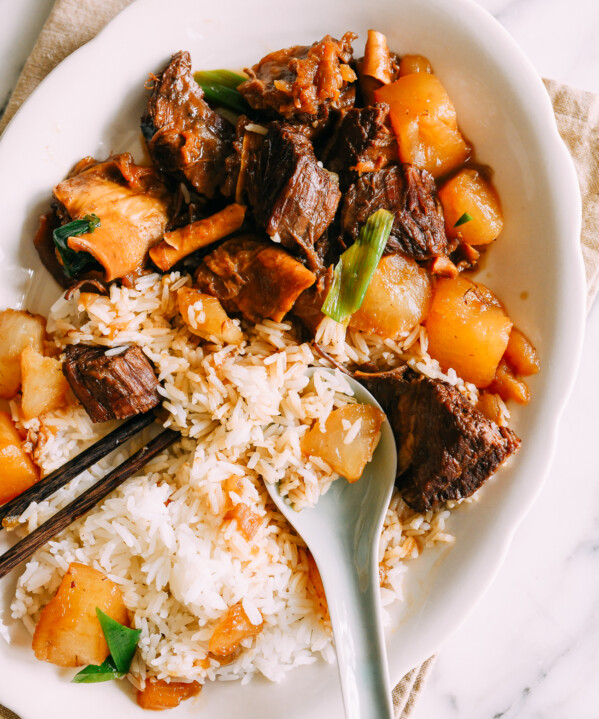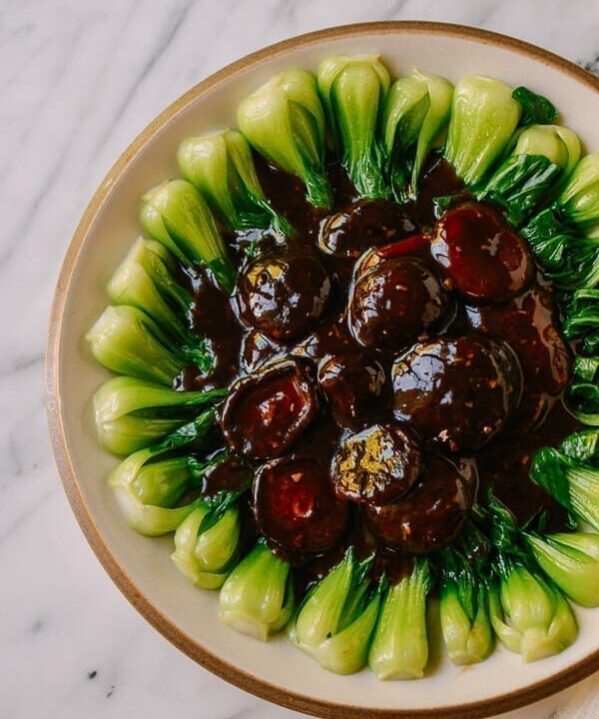This recipe for braised daikon with shiitake mushrooms is flavorful, healthy, and balanced. The mushrooms and daikon radish complement each other so well. Make this as a tasty side dish for any Asian meal.
What Is Daikon Radish?
Daikon radish is a large, elongated white radish known for its mild, sweet flavor and crisp texture. This root vegetable can get very large—as long as your arm! (In Japanese, the word “daikon” means “big root,” and that’s exactly what it is. In Mandarin, we call it “luóbo,” or if you’re speaking Cantonese like Bill’s family, it’s “lo bak.”
It’s such a versatile ingredient. Unlike those small red radishes that can be quite spicy, daikon has such a pleasant, mild taste that works nicely in both raw and cooked dishes.
You can pickle it, preserve it, boil it, stir-fry it, make it into lo bak go, or use it in soups. I really love braising it as I do in this recipe. The radish soaks up the flavor of the sauce and gets umami from the mushrooms. It’s so good!
How to Choose Daikon At the Store
When I’m shopping for daikon at the Asian market, I always look for ones with shiny, smooth white skin. Avoid any that look dull or that are starting to shrivel. Lift up the radish. It should feel nice and heavy for its size, which is how you know it’s still fresh and juicy inside. If you see any black spots or bruises, leave it behind! This means the daikon is old and potentially very bitter.
If green leaves are still attached to the radish, all the better! This indicates that the daikon is very fresh. I like to stir-fry the leaves. Sarah has made them into this daikon leaves furikake, a Japanese rice seasoning recipe from our friends at Just One Cookbook, which is also delicious and ideal if you only have a small amount of leaves.
While you can get very big daikon, smaller daikon are actually better for this recipe. (Which is perfect for us, because when we grow daikon in the garden, they’re somewhat small.) Small daikon tend to be sweeter and more tender. With smaller, narrower daikon, you can also slice them into rounds, which looks pretty. If your daikon is larger, halve or quarter it lengthwise before slicing.
Store daikon radish in a produce bag in the fridge for 1-2 weeks (depending on how old it was when you bought it).
If you haven’t cooked with daikon before, I hope you’ll give it a try! It’s one of those wonderful vegetables that’s not only delicious but also good for you – low in calories and full of nutrients and antioxidants.
Braised Daikon Recipe Instructions
Rinse your dried shiitake mushrooms to remove any dust and dirt, then add them to a bowl with the hot water. Cover with a plate to ensure the mushrooms are submerged, and soak for 2 hours, or overnight, until they are completely reconstituted.

Note:
In my everyday cooking, I like to use small shiitake mushrooms, as I find them to be more flavorful and less rubbery.
Squeeze the mushrooms dry. Allow any sediment to settle in the mushroom soaking liquid, and then pour it off into a measuring cup, stopping short of pouring in any sediment (discard the rest). Add additional water if needed so you have 1 cup.
Heat a medium pot (or your wok) over medium heat. Coat the bottom with neutral oil, and pan fry the mushrooms and ginger for a few minutes, until fragrant.

Add the daikon pieces along with the mushroom soaking liquid/water, star anise, bay leaf, oyster sauce, and light soy sauce.



Stir, cover, and cook for 20-25 minutes over medium heat, or until the daikon is tender and slightly translucent.
Check periodically to avoid burning and adjust the heat accordingly. Add more water during braising if needed (up to ¼ cup).
Uncover, and stir in the cornstarch slurry.


Cook until the sauce has thickened and coats the daikon and mushrooms. Add salt to taste if needed, top with chopped scallion if using, and serve!

Braised Daikon with Mushrooms

Ingredients
- ½ cup small dried shiitake mushrooms
- 1½ cups hot water
- 1 tablespoon neutral oil (such as vegetable, canola, or avocado oil)
- 1 large slice ginger
- 1¼ pounds daikon (halved lengthwise and cut into ½-inch/1.25cm thick pieces)
- 1 star anise
- 1 bay leaf
- 1 tablespoon oyster sauce (or vegetarian oyster sauce to make this vegan)
- 2 teaspoons light soy sauce
- 1 teaspoon cornstarch (mixed into a slurry with 1 tablespoon water)
- 1 tablespoon chopped scallion (optional garnish)
Instructions
- Rinse your dried shiitake mushrooms to remove any dust and dirt, then add them to a bowl with the hot water. Cover with a plate to ensure the mushrooms are submerged, and soak for 2 hours, or overnight, until they are completely reconstituted.
- Squeeze the mushrooms dry. Allow any sediment to settle in the mushroom soaking liquid, and then pour it off into a measuring cup, stopping short of pouring in any sediment (discard the rest). Add additional water if needed so you have 1 cup.
- Heat a medium pot (or your wok) over medium heat. Coat the bottom with neutral oil, and pan fry the mushrooms and ginger for a few minutes, until fragrant.
- Add the daikon pieces along with the mushroom soaking liquid/water, star anise, bay leaf, oyster sauce, and light soy sauce. Stir, cover, and cook for 20-25 minutes over medium heat, or until the daikon is tender and slightly translucent. Check periodically to avoid burning and adjust the heat accordingly. Add more water during braising if needed (up to ¼ cup).
- Uncover, and stir in the cornstarch slurry. Cook until the sauce has thickened and coats the daikon and mushrooms. Add salt to taste if needed, top with chopped scallion if using, and serve!




